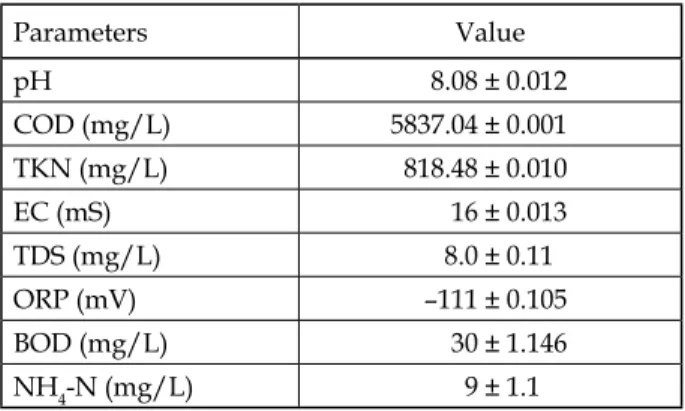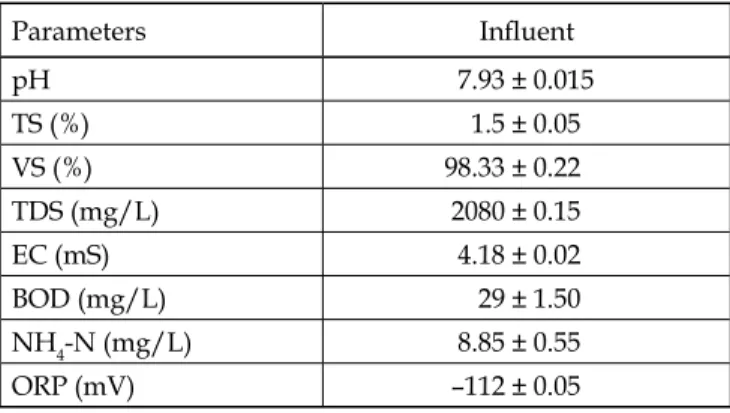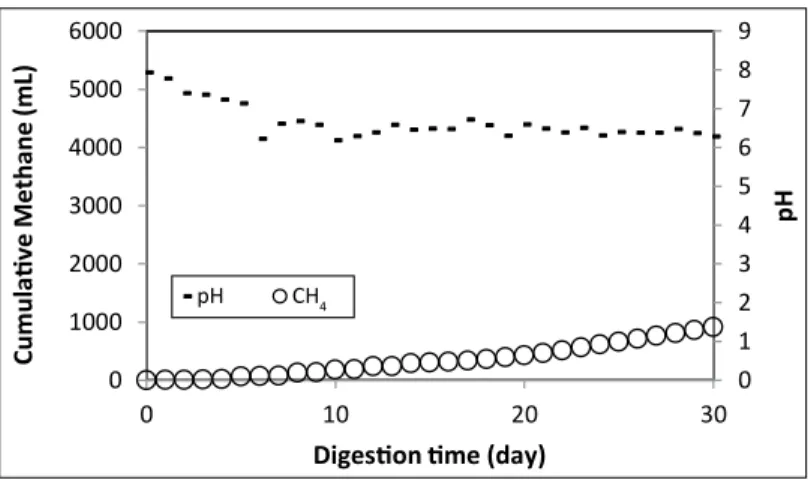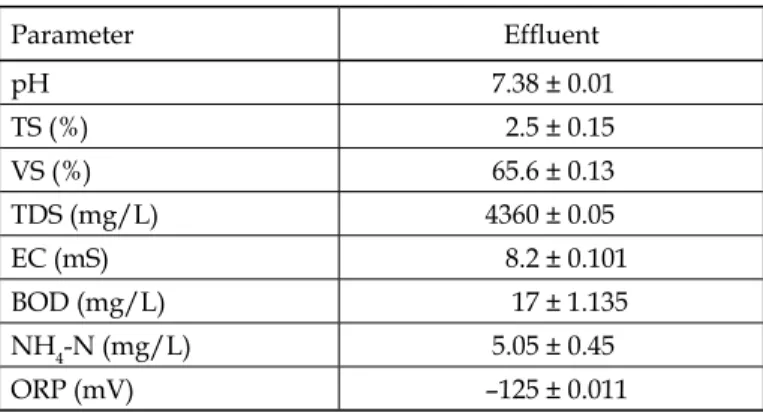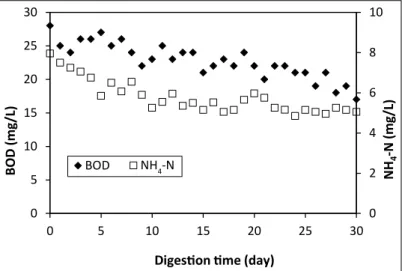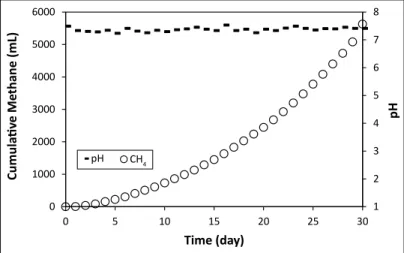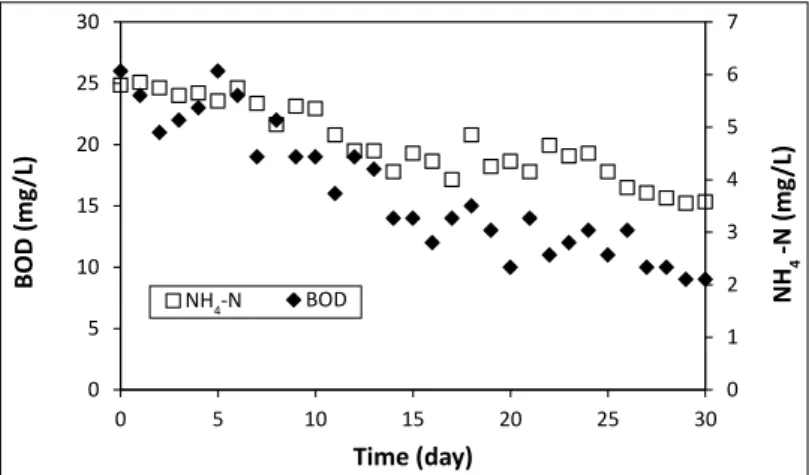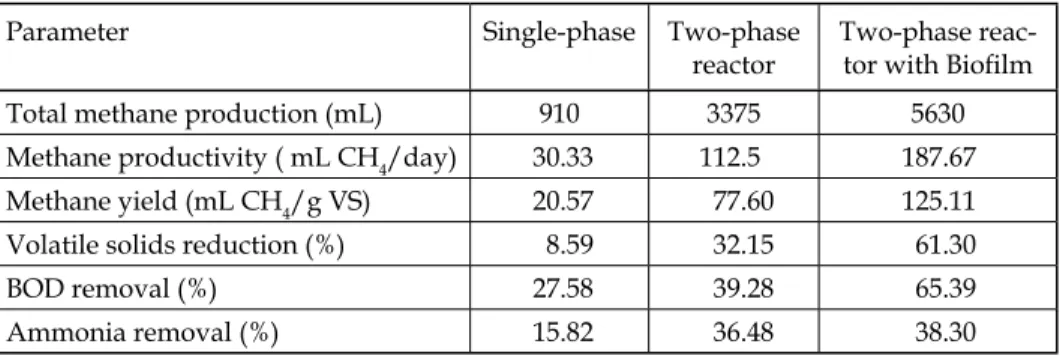Two-Stage Anae robic Co-digestion of Landfill Leachate and Starch Wastes Using
Anaerobic Biofilm Reactor for Methane Production
DARWIN*, ULFA TRIOVANTA, RIDHO RINALDI
* Corresponding author. E-mail address: darwin_ae@unsyiah.ac.id
Department of Agricultural Engineering, Syiah Kuala University, Banda Aceh 23111, Indonesia
1786-335X © 2019 Akadémiai Kiadó, Budapest Abstract. The study aims to evaluate two-stage anaerobic co-digestion of leachate and starch waste using anaerobic biofilm bioreactor to enhance methane production. The anaerobic digestion process was operated under the mesophilic condition at 35 ± 1 °C.
Hydraulic retention time (HRT) applied to the acidogenesis and methanogenesis reactors were 5 and 25 days, respectively. The organic loading rate (OLR) used in the process of acidogenesis was 2.91 gram volatile solid /L.day, while methanogenesis was 0.58 gram volatile solid (VS) per liter per day. Results showed that two-stage process using biofilm was an effective method for operating anaerobic co-digestion of starch waste and landfill leachate in which the system produced higher methane yield at 125.11 mL methane (CH4) per gram volatile solid (VS) added (mL.CH4/g.VS.added) in comparison to the single-stage process (20.57 mL CH4/g.VS.added) and two-stage process (77.60 mL CH4/g.VS.added) without using biofilm. Two-stage process using biofilm also effectively reduced organic matters in the culture in which the system reached 61% BOD removal in comparison to the single-stage process and two-stage process without biofilm that only had 27.6 and 39.3%
BOD removal, respectively. This study suggested that the two-stage process using biofilm would be the preferred technique for treating starch waste and landfill leachate.
Keywords: two-stage, landfill leachate, starch waste, methane
List of abbreviations
BOD = Biochemical Oxygen Demand; COD = Chemical Oxygen Demand; EC = Electrical Conductivity; HRT = Hydraulic Retention Time; g = gram; L = Liter; NH4-N = Ammoni- um Nitrogen; OLR = Organic Loading Rate; ORP = Oxidation Reduction Potential; TAN = Total Ammoniacal Nitrogen; TDS = Total Dissolved Solids; TKN = Total Kjedahl Nitro- gen; TS = Total Solids; VFA = Volatile Fatty Acids; VS = Volatile Solids
1. Introduction
Anaerobic digestion is the technology that has been widely recognized and applied in waste treatment process. This is due to the fact that the technol- ogy is effectively used for biologically treating the organic liquid and solid wastes prior to the disposal [1]. Currently, anaerobic digestion has become an attractive technology that has been developed for the conversion of or- ganic waste into valuable products such as renewable energy (i.e. biogas) and biofertilizer. Yenigün and Demirel [2] mentioned that recently study on anaerobic digestion has been conducted in various aspects including process performance and stability, operational and environmental parameters, inhi- bition and toxicity, and optimization of end-product formation. The types of feedstocks and/or substrates used would also be more attractive to study in the process of anaerobic digestion. This is due to the fact that the types of sub- strate used and pre-treatment methods applied in anaerobic digestion would significantly affect both the performance of anaerobic digestion process and the end-products produced [3, 4].
Starch wastes are a potential feedstock that could be used as a substrate for anaerobic digestion process. This is because they are available abundant- ly, and contain organic polymers high in carbohydrate [5]. Thus, anaerobic digestion of starch wastes could sustain the production of renewable energy without any competition with the global food stocks. Although starch wastes are biodegradable and easy to hydrolyze, the process of anaerobic digestion is somewhat instable. This is due to the fact that the starch wastes are easily digested, and thereby would potentially increase the formation of interme- diate products (i.e. organic acids and alcohols) during the acidogenesis [6].
Organic acids such as volatile fatty acids (VFA) and lactic acid build- up in the anaerobic digester would increase proton (H+) concentration, and thereby could lower pH in the culture. Acidic condition would toxify and in- hibit the process of anaerobic digestion, and thereby lead to the digester up- set [1, 7]. An imbalance between acid formation and acid utilization occurred since acidification phase that forms VFA could occur at low pH while meth- anogens that utilize VFA would be inhibited at low pH. Thus, this condition could lead to acid accumulation in the anaerobic digester [8, 9]. Study con- ducted by Yang et al. [9] revealed that a prolonged period of VFA accumula- tion and low pH in the digesters would decrease population of methanogens.
The authors found that acidic condition caused by the accumulation of VFA would significantly inhibit methanogenesis and the growth of methanogens.
The deficiency of trace elements of starch wastes would also limit the formation of methane gas. This is due to the fact that trace elements play significant role in anaerobic processes [10, 11]. Some studies showed that the life and growth of microbes during the process of anaerobic fermenta- tion would be highly dependent on the availability and/or sufficient sup-
ply of nutrients including trace elements, such as nickel, cobalt, and mo- lybdenum [12–14]. Therefore, it is crucial to find the solution to deal with the problems in regards to the deficiency of trace elements in starch waste, and an instable process of anaerobic digestion of starch wastes as a single substrate.
In order to overcome the problem of acid accumulation during the di- gestion of bio-degradable materials such as starch wastes, the technology of anaerobic co-digestion would be feasible to be applied by combining vari- ous types and/or different characteristics of substrates used [15]. Anaerobic co-digestion would generate some benefits as it could lower the operation- al cost of waste management, enhance digestion efficiency, and also could increase the buffer capacity to stabilize the process of anaerobic digestion [16, 17]. Some studies had revealed that anaerobic digestion could prevent VFA build-up in the digester, and would provide balance nutrients required for completing the process of anaerobic digestion to form methane as the end-product.
The substrate used in this study was starch waste, which was considered as biodegradable substrate with carbon-rich material [18]. Thus, it would be feasible to combine this substrate with another substrate which contains high concentration of ammonium nitrogen. This would be highly significant as the combination of the substrate with high content of carbon with the sub- strate with high concentration of ammonium nitrogen would enhance the ratio of carbon to nitrogen in the digester [17, 19]. By conducting co-digestion of these two substrates, the synergetic effect among organic substrates and the performance of anaerobic digestion process would be improved [20, 21].
Further, the balance of nutrients needed for the process of anaerobic diges- tion would also be enhanced [22].
In order to deal with the problems of the imbalance in nutrients during the process of anaerobic digestion of starch wastes, the use of landfill lea- chate as a co-substrate would be potential [23]. However, when landfill lea- chate is used as the single substrate for the process of anaerobic digestion, the performance of methanogens to form methane would be restricted by high concentration of ammonia [24]. Thus, by conducting anaerobic co-digestion of starch waste and landfill leachate, the process of digestion would be im- proved through balancing nutrients and carbon to nitrogen ratio.
Even if the process of anaerobic co-digestion could potentially enhance the production of methane due to the availability of sufficient and balanced nutrients, the risk of acid build-up would still be the major problem once the process is operated in the conventional single stage anaerobic digestion [8, 25]. This potentially occurs as the rate of organic acid or VFA production is higher than the rate of methane formation [26]. To deal with this problem, two-stage anaerobic digestion would be feasible to prevent acid accumula- tion in the single or conventional anaerobic digesters.
Two-stage anaerobic digestion would effectively prevent VFA and/
or organic acids accumulation in the digester as in this system the stage of acidification is conducted in the separated reactor of the methanogenesis re- actor [27]. Thus, the rapid production of organic acids during the acidogen- esis phase would not disturb the methanogenic activities [28]. Further, in the two-stage anaerobic digestion, the conversion of intermediates obtained from the acidification process into methane gas would easily be controlled.
This process would help methanogens to utilize VFA effectively in order to form methane as the end-product and to avoid acid accumulated in the re- actor, and thereby would significantly enhance methane productivity and yield [29].
In this present study, anaerobic digestion of starch waste was evaluated, and untreated raw landfill leachate was used as co-substrate. The objective of the study was to evaluate the performance of anaerobic co-digestion of starch waste and landfill leachate in single and two-stage processes. The current study also aimed to study the impact of the use of biofilm on methane yield and the effectiveness of starch waste treatment process, as well as to describe the effect of biofilm usage on the prevention of biomass washout during the conversion process of starch waste into methane.
2. Materials and methods
2.1. Substrate and leachate collection
The raw leachate used as co-substrate for this study was collected from the landfill area located in the Javanese Village, Banda Aceh, Indonesia. Starch waste used for this experiment was collected from the traditional markets lo- cated in Peunayong, Banda Aceh, Indonesia. After collecting, starch wastes are sorted and screened to remove any contaminants (i.e plastics, metals,
Table 1. Characteristics of leachate used
Parameters Value
pH 8.08 ± 0.012
COD (mg/L) 5837.04 ± 0.001
TKN (mg/L) 818.48 ± 0.010
EC (mS) 16 ± 0.013
TDS (mg/L) 8.0 ± 0.11
ORP (mV) –111 ± 0.105
BOD (mg/L) 30 ± 1.146
NH4-N (mg/L) 9 ± 1.1
woods, and stone/sands) that could inhibit the digestion process. The ma- jor components of the starch waste used were potatoes, cassava and corn starch. The collected starch waste was crushed, blended and homogenated.
The blended starch waste was stored in the fridge at ± 4 °C prior to use.
The characteristics of raw leachate landfill used as co-substrate are shown in Table 1.
2.2. Experimental procedures
Anaerobic co-digestion of starch waste and leachate was carried out in single and two-stage operations. A 10% inoculum used to speed up the inoculation process was taken from an anaerobic digester of cow manure. The process of anaerobic digestion was operated under the mesophilic condition at 35 ± 1oC.
To evaluate two-stage anaerobic digestion process, two sub-sequential reac- tors are utilized. In order to operate acidogenesis and methanogenesis pro- cess, each reactor used has a working volume of 3000 mL. Prior to the start of anaerobic digestion process, each reactor is purged with 100% N2 gas for 5–10 minutes in order to remove oxygen contamination. Hydraulic retention time (HRT) applied for acidogenesis process was 5 days while methanogenesis was 25 days. The flow rates applied to the acidogenesis and methanogenesis reactors were 600, and 120 mL/day, respectively. The organic loading rate (OLR) used in the process of acidogenesis and methanogenesis were 2.91, and 0.58 gram volatile solid per liter per day (g.VS/L.day).
In order to enhance the performance of anaerobic digesters for optimiz- ing methane productivity, biomass recycling system was applied by using biofilm carrier, which was installed inside in the reactor. In two-stage anaero- bic digestion, effluent generated from acidogenesis process will subsequently be used as a substrate for methanogenesis process. This process is applied to optimize the production of methange. Gas generated from methanogenesis reactor will be purified by 4 mol/L of sodium hydroxide solution.
2.3. Analytical methods
The parameters of influent and effluent obtained from anaerobic acidogenesis and methanogenesis reactors were analyzed in triplicates for pH, oxidation reduction potential (ORP), Total solids (TS), Volatile solids (VS), unseeded bi- ochemical oxygen demand (BOD), total kjedahl nitrogen (TKN), ammonium nitrogen (NH4-N), total dissolved solids (TDS), Electrical conductivity (EC).
Measurement of all parameters was carried out according to the Standard Methods [30]. Volatile solids reduction (%VS reduction) was analysed in or- der to evaluate the biodegradation efficiency during the process of anaerobic digestion, which was based on the formula mentioned in the previous studies [31, 32]. Methane production rates were measured as the volume of methane
generated per day, and the methane yield was measured according to the total methane produced per gram starch or volatile solids added [27, 31].
3. Results and discussion
3.1. Anaerobic co-digestion of leachate and starch wast in single-phase process
In order to evaluate the biodegradability of anaerobic co-digestion of starch waste and leachate in conventional/single stage process, continu- ous operation under the mesophilic condition was set up with the HRT of 25 days. Table 2 showed the characteristics of influent prior to the process of anaerobic digestion. This experiment showed that anaerobic co-diges- tion of starch waste and leachate has significant amount of organic materi- als that could potentially be used as a substrate for methane production in which the percentage of volatile solid represented as organic content was about 98.33%.
As shown in Table 2, the culture of anaerobic co-digestion of starch waste and leachate was somewhat alkaline in which pH influent obtained was about 7.93. This may indicate that the use of leachate as co-substrate would potentially contribute to the increase of ammonium nitrogen concentration required for balancing high carbon content in starch waste. This is in accord- ance with the study by Khalid et al. [34], which mentioned that nitrogen in the form of ammonium would contribute to stabilize pH in anaerobic culture.
Some studies revealed that nitrogen is a critical nutrient required for the syn- thesis of protein and the essence of microbial growth in the process of anaer- obic digestion [34, 35]. Nitrogeneous compounds that contain protein would be converted into ammonium via anaerobic digestion. During the process of
Table 2. Characteristics of influent from anaerobic co-digestion of leachate and starch waste in single stage process
Parameters Influent
pH 7.93 ± 0.015
TS (%) 1.5 ± 0.05
VS (%) 98.33 ± 0.22
TDS (mg/L) 2080 ± 0.15
EC (mS) 4.18 ± 0.02
BOD (mg/L) 29 ± 1.50
NH4-N (mg/L) 8.85 ± 0.55
ORP (mV) –112 ± 0.05
anaerobic digestion, microorganisms would utilize ammonium to form new cell mass [34, 36].
Results showed that anaerobic co-digestion of starch waste and leachate carried out in a single-stage operation did not peform satisfactorily in terms of methane production. As depicted in Fig. 1, the total methane production obtained in the process of anaerobic co-digestion of starch waste and raw landfill leachate was less than 1 liter (910 mL) within 30 days of digestion process. This could be attributed to the drop of pH during anaerobic diges- tion process in which pH culture dropped from 7.93 to 6.22 within 6 days of incubation period. The results are in accordance with the study by Liao et al.
[24], which revealed that anaerobic co-digestion of leachate and food waste in a single stage process had a problem of accumulated acid in the digester.
The authors found that a drop of pH was in the range between 4.98 and 5.42.
This indicated that acid build-up during the process of anaerobic digestion of foodwaste containing starch would still occur even if the anaerobic digestion was added a co-substrate of leachate which had a rich of nitrogen content.
In this experiment, a drop of pH started at day 6, and continuously oc- curred to the end of the anaerobic digestion process tested (day 30). This condition caused acidity in the anaerobic culture, and thereby lowered the production of methane as the end-product [37, 38]. This occurred as meth- anogens were quite sensitive in the low pH, and thereby the conversion of intermediates into methane could be inhibited [38]. The results of the experi- ments also showed that pH in the digester did not recover during the process of anaerobic digestion even if new fresh substrates were added continuously and the effluents were taken from the reactors simultaneously for 30 days of incubation. This is quite similar to the study conducted by Wang et al. [39], who found that the activitiy of methanogens could not be reconverted once
0 1 2 3 4 5 6 7 8 9
0 1000 2000 3000 4000 5000 6000
0 10 20 30
pH
CumulaƟve Methane (mL)
DigesƟŽn Ɵme (day) CH4
pH
Fig. 1. Cumulative methane production of anaerobic co-digestion of leachate and starch waste
they had been inhibited and exposed to the acidic condition. They reported that VFA accumulated in the digesters, especially propionic acids (900 mg/L) would significantly inhibit and suppress the activity of methanogens.
Results of the experiments also revealed that during the process of an- aerobic co-digestion of starch waste, the concentration of BOD did not de- crease significantly in which the concentration was in the range between 30 and 20 mg/L (Fig. 2). Further, the concentration of ammonia nitrogen fluctu- ated between 8.85 and 7.45 mg/L. This may indicate that the low pH in the anaerobic culture could inhibit the degradation of organic materials, thereby could affect the methanogens to produce methane from the oxidation of in- termediate products (i.e.VFA). This is in agreement with the study conducted
0 1 2 3 4 5 6 7 8 9 10
0 5 10 15 20 25 30 35
0 5 10 15 20 25 30
NH4 - N (mg/L)
BOD (mg/L)
DigesƟŽn Ɵme (day) BOD
NH4-N
Fig. 2. Variation of concentration of BOD and NH4-N during anaerobic co-digestion of leachate and starch waste
Table 3. Characteristics of effluent from anaerobic co-digestion of leachate and starch waste in single stage process
Parameters Effluent
pH 6.27 ± 0.03
TS (%) 2.47 ± 0.02
VS (%) 89.88 ± 0.022
TDS (mg/L) 1940 ± 0.011
EC (mS) 3.7 ± 0.015
BOD (mg/L) 21 ± 2.105
NH4-N (mg/L) 7.45 ± 1.002
ORP (mV) –236 ± 0.001
by Van Kessel and Russel [38], which revealed that the production of meth- ane would stop when pH of the culture was lower than 6.0. Further, they re- ported that the production of methane would recover once pH of the culture was increased to above 6.0.
3.2. Two-stage anaerobic co-digestion of leachate and starch waste
Results from the previous tests revealed that anaerobic co-digestion of starch waste and leachate operated in a conventional and/or single stage did not perform well and produced less methane due to low pH caused by acid ac- cumulation. In order to avoid acid accumulation and low pH during the pro- cess of anaerobic digestion, the process of co-digestion of starch waste and raw landfill leachate was carried out in the two-stage system. Results of the experiment showed that anaerobic co-digestion of starch waste and leachate operated in the two-stage system could increase methane production with about three times higher in total methane production (3.3 L) in comparison to the single-stage process (0.9 L). This occurred as pH in the process of two- stage anaerobic digestion was quite stable in which within 30 days of the operation pH culture was between 7.5 and 7.30 (Fig. 3, Tables 4, 5).
In terms of organic material removal, there was a tendency that BOD in the culture decreased from 28 to 17 mg/L (Fig. 4). This result is in agree- ment with the study by Satyawali and Balakrishnan [40] revealing that dur- ing the process of anaerobic digestion, the reduction of BOD indicated that the process of biomethanation occurred. Angelidaki et al. [41], mentioned
0 1 2 3 4 5 6 7 8
0 1000 2000 3000 4000 5000 6000
0 5 10 15 20 25 30
pH
CumulaƟve Methane (mL)
DigesƟon Ɵŵe (day) CH4
pH
Fig. 3. Cumulative methane production of two-stage anaerobic co-digestion of leachate and starch waste
that biomethanation would occur when the organic wastes/materials were decomposed and converted into biogas in which methane was formed as the end-product of methanogens’ activities.
As depicted in Fig. 4, experimental results also revealed that ammonium nitrogen tended to decline within 30 days of the digestion process in which the concentration slightly dropped from 8 to 5 mg/L. Study conducted by Serna-Maza et al. [42] found that total ammonical nitrogen (TAN) in the cul- ture could be significantly reduced when anaerobic digestion of food waste was operated in the semi-continuous system using a-side stripping process.
They added that TAN as well as organic nitrogen would be significantly re- duced when the process of anaerobic digestion was operated at high temper- atures (70 and 85 °C) and alkaline condition (pH 10). Maintaining the process
Table 4. Characteristics of influent from anaerobic co-digestion of leachate and starch waste in two-stage process
Parameter Influent
pH 7.52 ± 0.01
TS (%) 1.52 ± 0.015
VS (%) 96.67 ± 0.03
TDS (mg/L) 2820 ± 0.012
EC (mS) 8.19 ± 0.01
BOD (mg/L) 28 ± 0.011
NH4-N (mg/L) 7.95 ± 0.05
ORP (mV) –102 ± 0.001
Table 5. Characteristics of effluent from anaerobic co-digestion of leachate and starch waste in two-stage process
Parameter Effluent
pH 7.38 ± 0.01
TS (%) 2.5 ± 0.15
VS (%) 65.6 ± 0.13
TDS (mg/L) 4360 ± 0.05
EC (mS) 8.2 ± 0.101
BOD (mg/L) 17 ± 1.135
NH4-N (mg/L) 5.05 ± 0.45
ORP (mV) –125 ± 0.011
of anaerobic digestion at pH of 10 would increase the percentage of TAN reduction due to alkaline hydrolysis. In this current study, the concentration of NH4-N was somewhat too low (5–8 mg/L), which was similar to the study by Zhang et al. [23], reporting that low concentration of ammonia-N would indicate that most of nitrogen in anaerobic culture was in the form of organic nitrogen like protein.
3.3. Two-Stage anaerobic co-digestion of leachate and starch waste using biofilm
As anaerobic digestion was operated in a continuous mode, there was a ten- dency that the rate of biomass washout would be higher than the rate of biomass reproduction. If this occurred the production of methane would decrease once the process of anaerobic digestion was operated in the long period. Basri et al. [43] mentioned that biomass washout had been one of the main problems found in the process of anaerobic digestion operated in the continuous system. Thus, in order to prevent biomass washout and optimize methane production, anaerobic co-digestion of starch waste and leachate was conducted by attaching biofilm in the digesters.
Results of the experiments showed that anaerobic co-digestion operat- ed in two-stage process using biofilm could significantly increase methane production. The total production of methane from anaerobic co-digestion us- ing biofilm was about 67% higher than the co-digestion that was not using biofilm (Figs 3, 5). In terms of waste management process, attaching biofilm
0 2 4 6 8 10
0 5 10 15 20 25 30
0 5 10 15 20 25 30
NH4-N (mg/L)
BOD (mg/L)
DigesƟon Ɵŵe (day) BOD NH4-N
Fig. 4. Variation of concentration of BOD and NH4-Nduring two-stage anaerobic co-digestion of leachate and starch waste
in the digesters could help reduce the organic materials and/or organic pol- lutant presented in the waste stream. In this current study, the organic mate- rials represented in BOD was reduced significantly from 26 to 9 mg/L, and also ammonium nitrogen decreased from about 6 to 4 mg/L (Fig. 6). This is in agreement with the study by Lai et al. [44] revealing that the use of bio- film effectively reduced the organic materials in the coking wastewater. They mentioned that reactor attached with biofilm for treating wastewater could significantly reduce chemical oxygen demand (COD) and ammonia nitrogen concentration in which the percentage of COD and NH3-N removal obtained were about 96 and 99%, respectively.
Table 6. Characteristics of influent from anaerobic co-digestion of leachate and starch waste in two-stage process using biofilm
Parameter Influent
pH 7.49 ± 0.01
TS(%) 1.55 ± 0.015
VS (%) 96.77 ± 0.011
TDS (mg/L) 2720 ± 0.101
EC (mS) 3.61 ± 0.05
BOD (mg/L) 26 ± 1.125
NH4-N (mg/L) 5.8 ± 1.20
ORP (mV) –97.8 ± 0.22
1 2 3 4 5 6 7 8
0 1000 2000 3000 4000 5000 6000
0 5 10 15 20 25 30
pH
CumulaƟve Methane (mL)
Time (day) CH4
pH
Fig. 5. Cumulative methane production of two-stage anaerobic co-digestion of leachate and starch waste with biofilm
3.4. Biodegradation efficiency of anaerobic co-digestion
In order to evaluate the performance of anaerobic co-digestion process, as- sessment on the biodegradation efficiency was highly significant [45]. In this current study, some parameters used to evaluate the effectiveness of digesti- bility and/or coversion on anaerobic co-digestion included methane produc- tion and organics removal. Studies mentioned that some parameters used for determining the effectiveness of anaerobic digestion process include volatile solid reduction, total methane production and methane yield [45, 46].
Results of the experiments showed that anaerobic co-digestion of starch waste and leachate operated in the two-stage reactors with biofilm producing
Table 7. Characteristics of effluent from anaerobic co-digestion of leachate and starch waste in two-stage process using biofilm
Parameter Effluent
pH 7.41 ± 0.02
TS (%) 2.51 ± 0.04
VS (%) 37.45 ± 0.05
TDS (mg/L) 4350 ± 0.01
EC (mS) 5.11 ± 0.013
BOD (mg/L) 9 ± 1.105
NH4-N (mg/L) 3.58 ± 0.02
ORP (mV) –109 ± 0.001
0 1 2 3 4 5 6 7
0 5 10 15 20 25 30
0 5 10 15 20 25 30
NH4-N (mg/L)
BOD (mg/L)
Time (day) BOD
NH4-N
Fig. 6. Variation of concentration of BOD and NH4-Nduring two-stage anaerobic co-digestion of leachate and starch waste with biofilm
more methane per day (188 mL CH4/day) in comparison to the reactors op- erated in single stage system (30 mL CH4/day), and two-stage system with- out using biofilm (112 mL CH4/day). As presented in Table 8, methane yield obtained from the two-stage reactor using biofilm was about 125 mL CH4/g.
VS.added, which was about 61% higher than two-stage reactor without bio- film, and about six times higher than conventional or single-stage operation.
The finding of this research is in accordance with the study conducted by Michaud et al. [47] revealing that the methane yield increased with time dur- ing biofilm development indicating that the presence of biofilm in the reactor would provide the site for active biomass to stay longer in the anaerobic reac- tors, and help them convert and decompose organic materials into methane as the main end product. High methane yield obtained due to the fact that biofilm carrier attached into the reactors would enhance the development of biomass indicating that organic materials were highly required for microbial anabolism, and thereby would enhance the reduction as well as conversion of organic matters into methane [47].
The results of the current study also showed that the process of anaero- bic co-digestion of starch waste and leachate carried out in the two-stage op- eration using biofilm was more superior in terms of organic material removal in comparison to the two-stage process without using biofilm and the single stage operation. As shown in Table 8, the co-dgestion operated in the two- stage system using biofilm had the highest percentage of volatile solid (VS) reduction (61%) and BOD removal (65%), in comparison to the two-stage sys- tem that only had 32% of VS reduction and 39% of BOD removal, and also single-stage or conventional operation that had merely 8% and 27% of VS reduction and BOD removal, respectively. The results suggested two-stage anaerobic co-digestion of starch waste and leachate operated in the reactor using biofilm was more effective in degrading organic materials, and also the technology could be applied in order to enhance and optimize the pro- duction of methane as a renewable energy. The results of this study are also in agreement with the study by Karadag et al. [48] revealing that the use of
Table 8. Efficiency of digestion
Parameter Single-phase Two-phase
reactor Two-phase reac- tor with Biofilm
Total methane production (mL) 910 3375 5630
Methane productivity ( mL CH4/day) 30.33 112.5 187.67
Methane yield (mL CH4/g VS) 20.57 77.60 125.11
Volatile solids reduction (%) 8.59 32.15 61.30
BOD removal (%) 27.58 39.28 65.39
Ammonia removal (%) 15.82 36.48 38.30
biofilm in the process of anaerobic digestion could provide high performance stability and hybrid bioreactors, which significantly contributed to increase in methane production, and effectively enhancing organic matter reduction.
4. Conclusions
Anaerobic co-digestion of starch waste and landfill leachate operated in the two-stage system could help reduce a drop of pH, and minimize accumulat- ed acid in the bioreactors. In this process pH was stable in the range between 7.4 and 7.5, while pH in the single stage system dropped from 7.93 to 6.27.
A stable process in the two-stage anaerobic co-digestion generated almost four times higher methane production (3400 mL) in comparison to the single stage operation, which only had about 900 mL. Biofilm attached to the reac- tors operating the two-stage anaerobic co-digestion could effectively increase organics matter removal (65% of BOD removal), and significantly enhance methane productivity (188 mL CH4/day). This current finding is highly sig- nificant not only for the wastewater treatment plants but also for the industry producing gaseous biofuels.
Acknowledgements
The authors acknowledge financial support provided by Syiah Kuala Univer- sity, Banda Aceh, Indonesia through H-index research program coordinated by the Institute for Research and Community Services, UNSYIAH.
Conflict of interest
The author declares no potential conflicts of interest in regards to the re- search, authorship, and publication of this paper.
References
[1] Chen, Y., Cheng, J. J., Creamer, K. S. (2008). Inhibition of anaerobic digestion pro- cess: a review. Bioresource technology, 99(10), 4044–4064.
[2] Yenigün, O., Demirel, B. (2013). Ammonia inhibition in anaerobic digestion: a re- view. Process Biochemistry, 48(5–6), 901–911.
[3] Ariunbaatar, J., Panico, A., Esposito, G., Pirozzi, F., Lens, P. N. (2014). Pretreatment methods to enhance anaerobic digestion of organic solid waste. Applied energy, 123, 143–156.
[4] Koch, K., Helmreich, B., Drewes, J. E. (2015). Co-digestion of food waste in munici- pal wastewater treatment plants: effect of different mixtures on methane yield and hydrolysis rate constant. Applied Energy, 137, 250–255.
[5] Khongkliang, P., Kongjan, P., Sompong, O. (2015). Hydrogen and methane pro- duction from starch processing wastewater by thermophilic two-stage anaerobic digestion. Energy Procedia, 79, 827–832.
[6] Darwin, Cord-Ruwisch R., Charles W. (2018). Ethanol and lactic acid production from sugar and starch wastes by anaerobic acidification. Engineering in Life Scienc- es, 18, 635–642.
[7] Xu, Z., Zhao, M., Miao, H., Huang, Z., Gao, S., Ruan, W. (2014). In situ volatile fatty acids influence biogas generation from kitchen wastes by anaerobic diges- tion. Bioresource Technology, 163, 186–192.
[8] Wang, K., Yin, J., Shen, D., Li, N. (2014). Anaerobic digestion of food waste for volatile fatty acids (VFAs) production with different types of inoculum: effect of pH. Bioresource Technology, 161, 395–401.
[9] Yang, Yu, Meng Xu, Wall, J. D., Zhiqiang Hu. (2012). Nanosilver impact on meth- anogenesis and biogas production from municipal solid waste. Waste Manage- ment, 32, 5, 816–825.
[10] Zhang, L., Lee, Y. W., Jahng, D. (2011). Anaerobic co-digestion of food waste and piggery wastewater: focusing on the role of trace elements. Bioresource technolo- gy, 102(8), 5048–5059.
[11] Demirel, B., Scherer, P. (2011). Trace element requirements of agricultural biogas digesters during biological conversion of renewable biomass to methane. Biomass and Bioenergy, 35(3), 992–998.
[12] Bryant, M. P. (1979). Microbial methane production-theoretical aspects. Journal of Animal Science, 48, 193–201.
[13] Scherer, P., Sahm, H. (1981). Effect of trace elements and vitamins on the growth of Methanosarcina barkeri. Acta Biotechnology 1, 57–65.
[14] Schönheit, P., Moll, J., Thauer, R. K. (1979). Nickel, cobalt, and molybdenum re- quirement for growth of Methanobacterium thermoautotrophicum. Archives of Mi- crobiology, 123(1), 105–107.
[15] Mata-Alvarez, J., Mace, S., Llabres, P. (2000) Anaerobic digestion of organic solid wastes. An overview of research achievements and perspectives. Bioresource Tech- nology, 74(1), 3–16.
[16] Astals, S., Nolla-Ardèvol, V., Mata-Alvarez, J. (2012). Anaerobic co-digestion of pig manure and crude glycerol at mesophilic conditions: Biogas and digestate. Biore- source Technology, 110, 63–70.
[17] Wang, X., Yang, G., Feng, Y., Ren, G., Han, X. (2012). Optimizing feeding compo- sition and carbon–nitrogen ratios for improved methane yield during anaerobic co-digestion of dairy, chicken manure and wheat straw. Bioresource technology, 120, 78–83.
[18] Leung, C. C. J., Cheung, A. S. Y., Zhang, A. Y. Z., Lam, K. F., Lin, C. S. K. (2012).
Utilisation of waste bread for fermentative succinic acid production. Biochemical Engineering Journal, 65, 10–15.
[19] Cuetos, M. J., Gomez, X., Otero, M., Moran, A., 2008. Anaerobic digestion of solid slaughterhouse waste (SHW) at laboratory scale: influence of co-digestion withthe organic fraction of municipal solid waste (OFMSW). Biochem. Eng. J. 40, 99–106.
[20] Park, S., Li, Y. (2012). Evaluation of methane production and macronutrient degra- dation in the anaerobic co-digestion of algae biomass residue and lipid waste. Biore- source Technology, 111, 42–48.
[21] Xie, S., Wickham, R., Nghiem, L. D. (2017). Synergistic effect from anaerobic co-di- gestion of sewage sludge and organic wastes. International Biodeterioration & Bio- degradation, 116, 191–197.
[22] Pagés-Díaz, J., Pereda-Reyes, I., Taherzadeh, M. J., Sárvári-Horváth, I., Lundin, M. (2014). Anaerobic co-digestion of solid slaughterhouse wastes with agro-resi- dues: synergistic and antagonistic interactions determined in batch digestion as- says. Chemical Engineering Journal, 245, 89–98.
[23] Zhang, W., Zhang, L., Li, A. (2015). Anaerobic co-digestion of food waste with MSW incineration plant fresh leachate: process performance and synergistic ef- fects. Chemical Engineering Journal, 259, 795–805.
[24] Liao, X., Zhu, S., Zhong, D., Zhu, J., Liao, L. (2014). Anaerobic co-digestion of food waste and landfill leachate in single-phase batch reactors. Waste Manage- ment, 34(11), 2278–2284.
[25] Zhang, C., Su, H., Baeyens, J., Tan, T. (2014). Reviewing the anaerobic digestion of food waste for biogas production. Renewable and Sustainable Energy Reviews, 38, 383–392.
[26] Maspolim, Y., Zhou, Y., Guo, C., Xiao, K., Ng, W. J. (2015). Comparison of sin- gle-stage and two-phase anaerobic sludge digestion systems–Performance and mi- crobial community dynamics. Chemosphere, 140, 54–62.
[27] Parawira, W., Read, J. S., Mattiasson, B., Björnsson, L. (2008). Energy production from agricultural residues: high methane yields in pilot-scale two-stage anaerobic digestion. Biomass and Bioenergy, 32(1), 44–50.
[28] Park, Y., Hong, F., Cheon, J., Hidaka, T., Tsuno, H. (2008). Comparison of thermo- philic anaerobic digestion characteristics between single-phase and two-phase sys- tems for kitchen garbage treatment. Journal of Bioscience and Bioengineering, 105(1), 48–54.
[29] Salomoni, C., Caputo, A., Bonoli, M., Francioso, O., Rodriguez-Estrada, M. T., Palenzona, D. (2011). Enhanced methane production in a two-phase anaerobic di- gestion plant, after CO2 capture and addition to organic wastes. Bioresource Tech- nology, 102(11), 6443–6448.
[30] APHA, (2012) Standard Methods for the Examination of Water and Wastewater, American Public Health Association, Washington, D.C. U.S.A.
[31] Darwin, Cheng, J. J., Liu, Z., Gontuphil, J. (2016a). Anaerobic co-digestion of co- coa husk with digested swine manure: evaluation of biodegradation efficiency in methane productivity. Agricultural Engineering International: The CIGR Journal 18, 147–156.
[32] Darwin, Fazil A., Ilham, M., Sarbaini, Purwanto, S. (2017) Kinetics on anaerobic co-digestion of bagasse and digested cow manure with short hydraulic retention time. Research in Agricultural Engineering, 63(3), 121–127.
[33] Darwin, Cheng J. J., Gontupil J. Liu, Z. M. (2016). Influence of total solid concentra- tion for methane production of cocoa husk co-digested with digested swine ma- nure. International Journal of Environment and Waste Management 17, 1, 71–90.
[34] Khalid, A., Arshad, M., Anjum, M., Mahmood, T., Dawson, L. (2011). The anaerobic digestion of solid organic waste. Waste management, 31(8), 1737–1744.
[35] Kayhanian, M., Rich, D. (1995). Pilot-scale high solids thermophilic anaerobic Di- gestion of municipal solid waste with an emphasis on nutrientrequirements. Bio- mass Bioenergy 8, 433–444.
[36] Sawayama, S., Tada, C., Tsukahara, K., Yagishita, T. (2004). Effect of ammonium addition on methanogenic community in a fluidized bed anaerobic digestion. J.
Bioscience and Bioengineering 97, 65–70.
[37] Hook, S. E., Steele, M. A., Northwood, K. S., Wright, A. D. G., McBride, B. W. (2011).
Impact of high-concentrate feeding and low ruminal pH on methanogens and pro- tozoa in the rumen of dairy cows. Microbial Ecology, 62(1), 94–105.
[38] Van Kessel, J. A. S., Russell, J. B. (1996). The effect of pH on ruminal methanogene- sis. FEMS Microbiology Ecology, 20(4), 205–210.
[39] Wang, Y., Zhang, Y., Wang, J., Meng, L. (2009). Effects of volatile fatty acid concen- trations on methane yield and methanogenic bacteria. Biomass and bioenergy, 33(5), 848–853.
[40] Satyawali, Y., Balakrishnan, M. (2008). Wastewater treatment in molasses-based alcohol distilleries for COD and color removal: a review. Journal of Environmental Management, 86(3), 481–497.
[41] Angelidaki, I., Karakashev, D., Batstone, D. J., Plugge, C. M., Stams, A. J. (2011).
Biomethanation and its potential. Methods in Enzymology, 494, 327–351.
[42] Serna-Maza, A., Heaven, S., Banks, C. J. (2014). Ammonia removal in food waste anaerobic digestion using a side-stream stripping process. Bioresource Technolo- gy, 152, 307–315.
[43] Basri, M. F., Yacob, S., Hassan, M. A., Shirai, Y., Wakisaka, M., Zakaria, M. R., Phang, L. Y. (2010). Improved biogas production from palm oil mill effluent by a scaled-down anaerobic treatment process. World Journal of Microbiology and Biotech- nology, 26(3), 505–514.
[44] Lai, P., Zhao, H. Z., Zeng, M., Ni, J. R. (2009). Study on treatment of coking waste- water by biofilm reactors combined with zero-valent iron process. Journal of hazard- ous materials, 162(2–3), 1423–1429.
[45] Wilkie, A. C. (2005) Anaerobic digestion of dairy manure: Design and process con- sideration. Natural Resource, Agriculture, and Engineering Service, 176, 301–312.
[46] Mata-Alvarez, J., Dosta, J., Romero-Güiza, M. S., Fonoll, X., Peces, M., Astals, S.
(2014). A critical review on anaerobic co-digestion achievements between 2010 and 2013. Renewable and Sustainable Energy Reviews, 36, 412–427.
[47] Michaud, S., Bernet, N., Buffière, P., Roustan, M., Moletta, R. (2002). Methane yield as a monitoring parameter for the start-up of anaerobic fixed film reactors. Water Research, 36(5), 1385–1391.
[48] Karadag, D., Köroğlu, O. E., Ozkaya, B., Cakmakci, M. (2015). A review on anaer- obic biofilm reactors for the treatment of dairy industry wastewater. Process Bio- chemistry, 50(2), 262–271.
